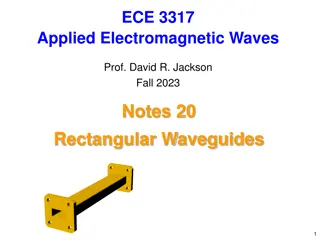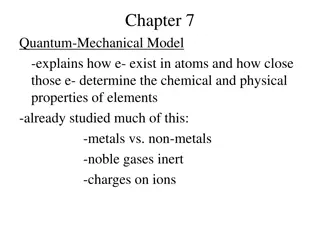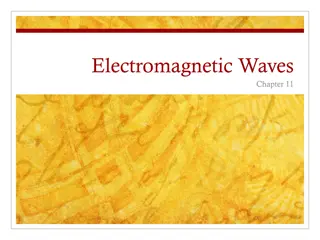Understanding Waveguides in Electromagnetic Theory
The concept of waveguides in electromagnetic theory involves the transmission of electromagnetic waves through hollow metallic tubes, such as rectangular and circular waveguides made from materials like copper and aluminum. These waveguides support different modes of propagation, including TE, TM, and TEM modes, each with distinct characteristics and applications. Understanding the types of waveguides and modes is essential for their efficient utilization in carrying energy between equipment pieces with varying bandwidth requirements.
Download Presentation

Please find below an Image/Link to download the presentation.
The content on the website is provided AS IS for your information and personal use only. It may not be sold, licensed, or shared on other websites without obtaining consent from the author. Download presentation by click this link. If you encounter any issues during the download, it is possible that the publisher has removed the file from their server.
E N D
Presentation Transcript
IDHAYA COLLEGE FOR WOMEN KUMBAKONAM 612 001 DEPARTMENT OF PHYSICS SEMESTER CLASS SUBJECT- INCHARGE SUBJECT NAME SUBJECT CODE TOPIC : : : : : : II I M.Sc PHYSCIS Mrs. T. KAVITHA ELECTRO MAGNETIC THEORY P16PY21 WAVE GUIDE AND ITS APPLICATIONS
CONCEPT OF WAVEGUIDE A hollow metallic tube of uniform cross section for transmitting electro magnetic waves by successive reflections from inner walls of the tube is called Waveguide.
Waveguide may be used to carry energy between pieces of equipments. Waveguides are made from Copper, Aluminium. These metals are extruded into long rectangular or circular pipes. TYPES OF WAVE GUIDE 1.RECTANGULAR WAVEGUIDE 2.CIRCULAR WAVEGUIDE
RECTANGULAR WAVEGUIDE Dominant mode is TE10 Supports TE and TM waves but not TEM waves There is only one conductor Bands between 1GHz to above 220 GHz
CIRCULAR WAVEGUIDE The dominant mode is TE11 The highest possible bandwidth allowing only a single mode to propagate.
TYPES OF MODES TE(TRANSVERSE ELECTRIC )MODE Electric field perpendicular to direction of propagation Magnetic components are in the direction of propagation TE modes have no electric field in direction of propagation TE mode is subdivided into TE10,TE11,TE20,TE01 The dominant mode is TE11
TM(TRANSVERSE MAGNETIC )MODE Magnetic field perpendicular to direction of propagation Electric components are in the direction of propagation TE modes have no magnetic field in direction of propagation TM mode is subdivided into TM11,TM21
TEM MODE Both electric and magnetic field perpendicular to direction of propagation TEM mode is subdivided into TM11,TM21
RECTANGULAR WAVEGUIDE Mode Cut-off Wavelength( c) Cut-off Frequency( fc) ( 1/( )0.5) (1/(2a)) TE10 2a ( 1/( )0.5) ((a2+ b2)0.5/(2ab)) TE11, M11 (2ab)/(a2 + b2)0.5 ( 1/( )0.5) (1/a) TE20 a ( 1/( )0.5) (1/(2b)) TE01 2b
CIRCULAR WAVEGUIDE Cut-off Frequency( fc) Cut off Wavelength( c) Mode TE11 1.706d ( 1/( )0.5) (1/(1.706d)) TM01 1.306d ( 1/( )0.5) (1/(1.306d)) TE21 1.028d ( 1/( )0.5) (1/(1.028d)) TM11 0.820d ( 1/( )0.5) (1/(0.820d))
APPLICATIONS To reduce Attenuation loss. Can operate frequencies Short and medium distance broad band communication only above certain
CAVITY RESONATOR AND ITS APPLICATIONS AND ITS APPLICATIONS
CONCEPT OF CAVITY RESONATOR An electronic device consisting of a space usually enclosed by metallic walls within which resonant electromagnetic fields may be excited and extracted for use in microwave systems.
TYPES OF CAVITY RESONATOR Regulated Cavity Resonator. Un Regulated Cavity Resonator. Co-axial Cavity Resonator. Capacitive Cavity Resonator. Inductive Cavity Resonator. Waveguide Cavity Resonator. Reentrant Cavity Resonator.
APPLICATIONS OF CAVITY RESONATOR Waveguides are used at the highest frequencies to transmit power and signals. Similarly, cavity resonators are employed as tuned circuits at such frequencies. Cavity resonators are widely used as the frequency determining element in microwave oscillators.























